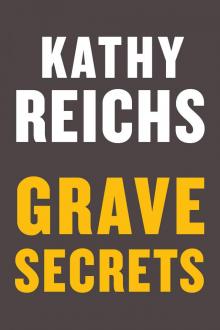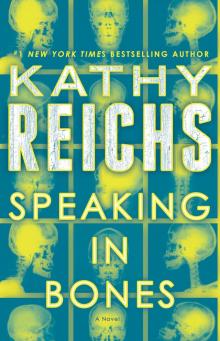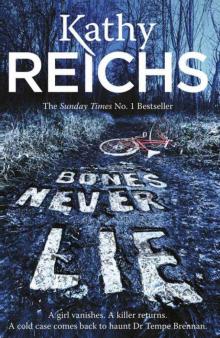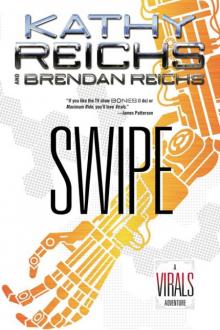- Home
- Kathy Reichs
Deadly Decisions Page 2
Deadly Decisions Read online
Page 2
I tried dialing, but the signal cut in and out. That’s why I’d left the phone in the van. Damn. Though my French had become fluent over the past ten years, background noise and bad connections often caused me problems. Between the language exchange and the weak signal, I’d never get the message straight on this phone. I had to hike down to headquarters.
I unzipped my Tyvek jumpsuit and threw it in a box in the back of the van. Slinging my pack over my shoulder, I headed downhill.
High above the trees a hawk circled some falconid target. The sky was a brilliant blue, with randomly spaced cotton puff clouds drifting leisurely. The course is usually held in May, and we’d worried that this year’s April scheduling might mean rain or cooler temperatures. No problem. The mercury was in the high seventies.
As I walked, I took in the sounds around me. My boots crunching on gravel. Birdsong. The whumping of helicopter blades low overhead. The pop of distant gunfire. The FBI shares Quantico with other federal police agencies and with the Marine Corps, and the activity is constant and very earnest.
The gravel road met blacktop at Hogan’s Alley, just below the simulated town square used by the FBI, DEA, ATF, and others. I skirted far to the left to avoid intruding on a hostage rescue exercise and turned right on Hoover Road downhill to the closest module of a concrete complex of gray and tan with antennae jutting from the highest roofs like new shoots in an old hedge. Crossing a small parking area to the Forensic Science Research and Training Center, I rang a bell at the loading dock.
A side door parted and a man’s face appeared in the crack. Though young, he was completely bald, and looked as if he’d been that way for some time.
“Finishing early?”
“No. I need to call my lab.”
“You can use my office.”
“Thanks, Craig. I’ll only be a minute.” I hope.
“I’m checking equipment, so take your time.”
The academy is often compared to a hamster cage because of the labyrinth of tunnels and corridors connecting its various buildings. But the upper floors are nothing compared with the maze below.
We wound our way through an area stacked with crates and cardboard boxes, old computer screens, and metal equipment trunks, down one corridor, then along two others to an office barely large enough to hold a desk, chair, filing cabinet, and bookshelf. Craig Beacham worked for the National Center for the Analysis of Violent Crime, NCAVC, one of the major components of the FBI’s Critical Incident Response Group, CIRG. For a time the entity had been called the Child Abduction and Serial Killer Unit, CASKU, but had recently reverted to the original name. Since the training of evidence recovery technicians, or ERT’s, is one of the functions of NCAVC, it is this unit that organizes the annual course.
When dealing with the FBI, one must be alphabet savvy.
Craig gathered folders from his desk and stacked them on the cabinet.
“At least that will give you some space to take notes. Do you need to close the door?”
“No, thanks. I’m fine.”
My host nodded, then disappeared down the hall.
I took a deep breath, made a mental shift to French, and dialed.
“Bonjour, Temperance.” Only LaManche and the priest who baptized me have ever used the formal version. The rest of the world calls me Tempe. “Comment ça va?”
I told him I was fine.
“Thank you for calling back. I fear we have a grisly situation up here and I am going to need your help.”
“Oui?” Grisly? LaManche was not prone to overstatement.
“Les motards. Two more are dead.”
Les motards. Bikers. For more than a decade rival outlaw motorcycle gangs had been battling for control of the drug trade in Quebec. I’d worked on several motard cases, gunshot victims who had also been burned beyond recognition.
“Oui?”
“So far, this is what the police have reconstructed. Last night three members of the Heathens drove to the Vipers’ clubhouse with a powerful homemade bomb. The Viper working the surveillance cameras spotted a pair approaching with a large bundle between them. He took a shot and the bomb exploded.” LaManche paused. “The driver is in the hospital in critical condition. For the other two, the largest portion of tissue recovered weighs nine pounds.”
Ouch.
“Temperance, I’ve been trying to get in touch with Constable Martin Quickwater. He’s there in Quantico, but he’s been in a case-review meeting all day.”
“Quickwater?” It was not a typical québécois name.
“He’s Native. Cree, I think.”
“Is he with Carcajou?”
Opération Carcajou is a multijurisdictional task force created to investigate criminal activities among outlaw motorcycle gangs in the province.
“Oui.”
“What would you like me to do?”
“Please tell Constable Quickwater what I have told you, and have him contact me. Then I would like you to come here as quickly as possible. We may have difficulty with these identifications.”
“Have they recovered printable digits or dental fragments?”
“No. And it is not likely.”
“DNA?”
“There may be problems with that. The situation is complicated and I would rather not discuss it by phone. Is it possible for you to return earlier than you had planned?”
Following my normal pattern, I’d wrapped up the spring term at UNC-Charlotte in time to teach the FBI course. Now I only had to read the final exams. I’d been looking forward to a brief stay with friends in D.C. before flying to Montreal for the summer. The visit would have to wait.
“I’ll be there tomorrow.”
“Merci.”
He continued in his very precise French, either sadness or fatigue deepening the timbre of his rich, bass voice.
“This does not look good, Temperance. The Heathens will undoubtedly retaliate. Then the Vipers will draw more blood.” I heard him pull a long breath, then exhale slowly. “I fear the situation is escalating to full-scale war in which innocents may perish.”
We hung up and I called US Airways to arrange for a morning flight. As I was replacing the receiver Craig Beacham appeared in the doorway. I explained about Quickwater.
“Constable?”
“He’s RCMP. Royal Canadian Mounted Police. Or GRC if you prefer French. Gendarmerie royale du Canada.”
“Um. Huh.”
Craig punched in a number and asked about the constable’s whereabouts. After a pause he jotted something down and hung up.
“Your guy’s in a major case management session in one of the conference rooms down here.” He offered the number he’d written, then gave me directions. “Just slide in and take a seat. They’ll probably break at three.”
I thanked him, and wormed my way through the halls until I’d located the room. Muffled voices came through the closed door.
My watch said two-twenty. I turned the knob and slipped in.
The room was dark save for the beam of a projector and the apricot glow of an illuminated slide. I could make out half a dozen figures seated around a central table. Some heads turned in my direction as I eased into a chair against the side wall. Most eyes stayed fixed on the screen.
For the next thirty minutes I saw LaManche’s premonition brought to life in horrifying detail. A bombed-out bungalow, tissue spattered on the walls, body parts strewn across the lawn. A female torso, face a red mass, skull bones mushroomed by a shotgun blast. The blackened chassis of a sports utility vehicle, one charred hand dangling from a rear window.
A man seated to the right of the projector commented about biker gang wars in Chicago as he clicked through the presentation. The voice was vaguely familiar, but I couldn’t make out the features.
More shootings. Explosions. Stabbings. Now and then I scanned the silhouettes around the table. Only one had hair that was not closely cropped.
Finally, the screen blazed white. The projector hummed and dust motes flo
ated in its beam. Chairs squeaked as their occupants stretched and reoriented toward one another.
The speaker rose and crossed to the wall. When the overhead lights came on I recognized him as Special Agent Frank Tulio, a graduate of the recovery course from years back. He spotted me, and a smile spread across his face.
“Tempe. How’s it hanging?”
Everything about Frank was precise, from his razor-cut gray hair, to his compact body, to his immaculate Italian-made shoes. Unlike the rest of us, throughout the bug and body exercises Frank had remained perpetually well groomed.
“Can’t complain. Are you still with the Chicago office?”
“Up until last year. I’m here now, assigned to CIRG.”
Every eye was focused on us, and I was suddenly conscious of my current state of cleanliness and coiffure. Frank turned to his colleagues.
“Does everyone know the great bone doctor?”
As Frank made introductions, those around the table smiled and nodded. Some I recognized, others I did not. One or two made jokes about past episodes in which I’d played a role.
Two of those present were not affiliated with the academy. The fuller hair I’d spotted belonged to Kate Brophy, supervisor of the Intelligence Unit of North Carolina’s State Bureau of Investigation. Kate had been the SBI’s expert on outlaw motorcycle gangs for as long as I could remember. We’d met in the early eighties when the Outlaws and Hells Angels were at war in the Carolinas. I’d identified two of the victims.
At the far end of the table a young woman typed on what looked like a stenotype machine. Next to her Martin Quickwater sat behind a laptop computer. His face was broad, with high cheekbones, and eyebrows that angled up at the ends. His skin was the color of fired brick.
“I’m sure you two foreigners know each other,” said Frank.
“Actually, we don’t,” I said. “But that’s why I’m intruding. I need to speak to Constable Quickwater.”
Quickwater graced me with approximately five seconds of attention, then his eyes went back to his computer screen.
“Good timing. We’re ready for a break.” Frank looked at his watch, then crossed back to click off the projector. “Let’s get some caffeine and regroup at three-thirty.”
As the agents filed past me one of the members of NCAVC made an exaggerated show of squaring his fingers and peering through, as though focusing on me through a viewfinder. We’d been friends a decade and I knew what was coming.
“Nice do, Brennan. Do you get a deal from your lawn man? Hedges and hair trims, one price?”
“Some of us do real work, Agent Stoneham.”
He moved on, laughing.
When only Quickwater and I were left, I smiled and began a fuller introduction.
“I know who you are,” said Quickwater in softly accented English.
His abruptness surprised me, and I fought back an equally impolite rejoinder. Perhaps being sweaty and uncombed had made me touchy.
When I explained that LaManche had been trying to reach him, Quickwater slipped his pager from his belt, checked the screen, then tapped it hard against his hand. Shaking his head and sighing, he reattached the device to his waistband.
“Batteries,” he said.
The constable watched me intently as I repeated what LaManche had said. His eyes were so deeply brown it was impossible to see a boundary between pupil and iris. When I’d finished, he nodded, then turned and left the room.
I stood a moment, wondering at the man’s odd demeanor. Terrific. I not only had two vaporized bikers to piece together, I now had Constable Congenial as an associate.
I picked up my pack and headed back to the woods.
No problem, Mr. Quickwater. I’ve cracked tougher nuts than you.
THE TRIP TO MONTREAL WAS UNEVENTFUL, EXCEPT FOR AN OVERT snub by Martin Quickwater. Though we were on the same flight, he did not speak to me or move to one of the empty seats in my row. We nodded at Washington-Reagan, then again as we waited in the customs line at Montreal’s Dorval. His coolness suited me. I really didn’t want to deal with the man.
I took a taxi to my condo in Centreville, offloaded luggage, and zapped a frozen burrito. My old Mazda turned over after three tries, and I headed to the city’s east side.
For years the forensic lab had been located on the fifth floor of a structure known as the SQ building. The provincial police, or Sûreté du Québec, had the rest of the floors, except for my office and a detention center on the twelfth and thirteenth. The morgue and autopsy rooms were in the basement.
The Quebec government had recently spent millions to renovate the building. The jail was relocated, and the medico-legal and crime labs now sprawled throughout the top two floors. It had been months since the move, but I still couldn’t believe the change. My new office had a spectacular view of the St. Lawrence River, and my lab was first-rate.
At three-thirty on Friday the normal weekday hustle and bustle were beginning to taper off. One by one doors were closing, and the army of lab-coated scientists and technicians was dwindling.
I unlocked my office and hung my jacket on the wooden hall tree. Three white forms lay on my desk. I selected the one with LaManche’s signature.
The “Demande d’Expertise en Anthropologie” is often my first introduction to a case. Filled out by the requesting pathologist, it provides data critical to tracking a file.
My eyes drifted down the right-hand column. Lab number. Morgue number. Police incident number. Clinical and efficient. The body is tagged and archived until the wheels of justice have run their course.
I shifted to the left column. Pathologist. Coroner. Investigating officer. Violent death is the final intrusion, and those who investigate it are the ultimate voyeurs. Though I participate, I am never comfortable with the indifference with which the system approaches the deceased and the death investigation. Even though a sense of detachment is a must to maintain emotional equilibrium, I always have the feeling that the victim deserves something more passionate, more personal.
I scanned the summary of known facts. It differed from LaManche’s telephone account in only one respect. To date, two hundred and fifteen remnants of flesh and bone had been recovered. The largest weighed eleven pounds.
Ignoring the other forms and a stack of phone messages, I went to find the director.
I’d rarely seen Pierre LaManche in anything but lab-coat white or surgical green. I couldn’t imagine him laughing or wearing plaid. He was somber and kind, and strictly tweed. And the best forensic pathologist I knew.
I spotted him through the rectangle of glass beside his office door. His rangy form was hunched over a desk heaped with papers, journals, books, and a stack of files in all the primary colors. When I tapped he looked up and gestured me in.
The office, like its occupant, smelled faintly of pipe tobacco. LaManche had a manner of moving silently, and sometimes the scent was my first clue to his presence.
“Temperance.” He accented the final syllable and made it rhyme with France. “Thank you so much for returning early. Please, sit down.”
Always the perfect French, with never a contraction or word of slang.
We took places at a small table in front of his desk. On it lay a number of large brown envelopes.
“I know it is too late to begin analysis now, but perhaps you are willing to come in tomorrow?”
The face was army mule long with deep, vertical creases. When he raised his brows in a question, the furrows paralleling his eyes elongated and veered toward the midline.
“Yes. Of course.”
“You might want to begin with the X rays.”
He indicated the envelopes, then swiveled to his desk.
“And here are the scene and autopsy photos.” He handed me a stack of smaller brown envelopes and a videocassette.
“The two bikers carrying the bomb to the Vipers’ clubhouse were pulverized, their remains scattered over an enormous area. A lot of what the recovery team is finding is stuck to
walls and caught in bushes and tree branches. Amazingly, the largest fragments retrieved so far have come from the clubhouse roof. One chunk of thorax has a partial tattoo that will be useful for establishing identity.”
“What about the driver?”
“He died in the hospital this morning.”
“The shooter?”
“He is in custody, but these people are never helpful. He will go to jail rather than give anything to the police.”
“Even information about a rival gang?”
“If he talks, he is probably a dead man.”
“Are there still no dentals or prints?”
“Nothing.”
LaManche ran a hand over his face, raised and lowered his shoulders, then laced his fingers in his lap.
“I fear we will never get all the tissue sorted out.”
“Can’t we use DNA?”
“Have you heard the names Ronald and Donald Vaillancourt?”
I shook my head.
“The Vaillancourt brothers, Le Clic and Le Clac. Both are full patch members of the Heathens. One was implicated a few years back in the execution of Claude ‘Le Couteau’ Dubé. I don’t remember which.”
“The police think the Vaillancourts are the victims?”
“Yes.”
The melancholy eyes looked into mine.
“Clic and Clac are identical twins.”
• • •
By seven that evening I’d examined everything but the video. Using a magnifier I’d gone over scores of photos showing hundreds of bone fragments and bloody masses of varying shapes and sizes. In shot after shot arrows pointed to red and yellow globs lying in grass, entangled in branches, and flattened against cinder blocks, broken glass, tar-paper roofing, and corrugated metal.
The remains had arrived at the morgue in large black plastic bags, each containing a collection of Ziploc bags. Each bag was numbered and held an assortment of body parts, dirt, fabric, metal, and unidentifiable debris. The autopsy photos moved from the unopened bags, to shots of the small plastic sacks grouped on autopsy tables, to views of the contents sorted by categories.

 Two Nights
Two Nights The Bone Collection: Four Novellas
The Bone Collection: Four Novellas Fatal Voyage
Fatal Voyage 206 Bones
206 Bones Bones to Ashes
Bones to Ashes Terminal
Terminal Monday Mourning
Monday Mourning Flash and Bones
Flash and Bones Cross Bones
Cross Bones Devil Bones
Devil Bones Break No Bones
Break No Bones Swamp Bones
Swamp Bones Déjà Dead
Déjà Dead Shock
Shock Spider Bones
Spider Bones Death Du Jour
Death Du Jour Grave Secrets
Grave Secrets Trace Evidence: A Virals Short Story Collection
Trace Evidence: A Virals Short Story Collection Bones on Ice
Bones on Ice The Bone Code
The Bone Code Bones in Her Pocket
Bones in Her Pocket Seizure:
Seizure: Speaking in Bones
Speaking in Bones Deadly Decisions
Deadly Decisions Spike
Spike Bones Never Lie
Bones Never Lie Bones of the Lost
Bones of the Lost Virals 03.5 - Swipe
Virals 03.5 - Swipe Exposure
Exposure A Conspiracy of Bones
A Conspiracy of Bones Shift (tory brennan)
Shift (tory brennan) Bones of the Lost: A Temperance Brennan Novel tb-16
Bones of the Lost: A Temperance Brennan Novel tb-16 Virals tb-1
Virals tb-1 Bones Are Forever tb-15
Bones Are Forever tb-15 Code tb-3
Code tb-3 Seizure tb-2
Seizure tb-2 Deadly Descisions
Deadly Descisions Spider Bones: A Novel
Spider Bones: A Novel